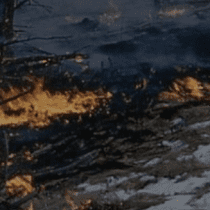Fire Behavior
The Advanced Burn Boss Workshop and Fire Science Symposium (click “Log in as Guest” in the event portal) is a combined virtual event that will provide targeted training for burn bosses: RT300, IFTDSS, and smoke modeling, as well as interactive presentations for a wide audience that bridge research and practice using the three pillars of the Cohesive Strategy: Resilient Ecosystems, Fire Adapted Communities, and Safe and Effective Wildfire Response.
Alison Dean, Central Oregon Fire Management Service and U.S. Bureau of Land Management, and Marth Brabec, City of Boise, will provide an overview of historic and modern fire behavior in different communities of the sagebrush biome, shrub steppe ecology, and post-fire restoration considerations.
Improving decision processes and the informational basis upon which decisions are made in pursuit of safer and more effective fire response have become key priorities of the fire research community. One area of emphasis is bridging the gap between fire researchers and managers through development of application-focused, operationally relevant decision support tools. In this paper we focus on a family of such tools designed to characterise the difficulty of suppression operations by weighing suppression challenges against suppression opportunities. These tools integrate potential fire behaviour, vegetation cover types, topography, road and trail networks, existing fuel breaks and fireline production potential to map the operational effort necessary for fire suppression. We include case studies from two large fires in the USA and Spain to demonstrate model updates and improvements intended to better capture extreme fire behaviour and present results demonstrating successful fire containment where suppression difficulty index (SDI) values were low and containment only after a moderation of fire weather where SDI values were high. A basic aim of this work is reducing the uncertainty and increasing the efficiency of suppression operations through assessment of landscape conditions and incorporation of expert knowledge into planning.
In the Western U.S., the 2020 fire season is setting new records in terms of geographic scale, fire intensity, and rates of spread. Tens of millions of people are currently being forced to breathe beneath a dense layer of smoke, as others have lost their lives and property.
With each new record-setting fire, the same question comes up again and again: is this due to climate change, or is this due to forest mismanagement? After dueling appearances on Monday, this question now appears to be a matter of debate in the Presidential campaign.
The climate change vs. management question ignores nuance that is crucial for finding scientific answers and policy solutions. The factors influencing wildfire behavior are complex, and the dominant drivers vary between different locations and events. Below are five key things to know about the causes of the current wildfire problem. Understanding them can help us navigate the question of what is driving increased fire activity and what can be done to reduce such large fires in the future.
Access WildfireSAFE
WildfireSAFE provides simplified access to an advanced suite of fire weather and fire products. The Wildland Fire Assessment System (WFAS) is a USDA Forest Service, Fire and Aviation Management-supported system that was developed by Forest Service fire behavior researchers as an avenue to increase the utility of remote sensing and spatial data in fire management. It is an integrated, web-based resource to support fire management decisions. It provides multi-temporal and multi-spatial views of fire weather and fire potential, including fuel moistures and fire danger classes from the US National Fire Danger Rating System (NFDRS), Keetch-Byram and Palmer drought indices, lower atmospheric stability and satellite-derived vegetation conditions. It also provides access to fire potential forecasts from 24 hours to 7 days. Wildfire SAFE integrates WFAS with federal agency incidents to provide targeted fire weather information on an incident basis.
View report.
Numerical weather prediction (NWP) models can produce high-resolution forecasts of gust front conditions, and identifying these conditions from the model outputs may provide enhanced fire weather guidance. Abrupt changes in wind direction and speed can dramatically impact wildfire development and spread. Most importantly, such changes can pose significant problems to firefighting efforts and have resulted in a number of fire fatalities over the years. Frequent causes of such wind shifts are thunderstorm and convective system outflows, known as gust fronts, and the identification and prediction of these present critical challenges for fire weather forecasters. Anticipating and warning of these phenomena in wildland fire situations thus represent opportunities for enhancing the safety of incident personnel and the effectiveness of the firefighting operations. With these considerations we have developed a software tool to identify and depict convective outflow boundaries in high-resolution numerical weather prediction (NWP) models to provide guidance for fire weather forecasting.
Access courses.
These online courses were developed by Wildland Fire Management Research, Development, and Application, Fire Regime Condition Class, LANDFIRE, National Wildfire Coordinating Group, and National Advanced Fire and Resource Institute.
Description: Oregon State University’s Forestry & Natural Resources Extension Fire Program and its partners present a webinar series on Wildfire Preparedness and Prevention in Oregon. The second of three webinars focuses on fire behavior and the home ignition zone (HIZ). We’ll discuss the fire environment and the built environment. Presenters will break down the HIZ and discuss what people can do in each zone. Further, they’ll talk about opportunities to support your mitigation efforts.
Presenters:
Daniel Leavell, Oregon State University
Stephen Fitzgerald, Oregon State University
Jenna Trentadue, Oregon Department of Forestry
Ryan Gordon, Oregon Department of Forestry
Megan Fitzgerald-McCowan, National Fire Protection Association (NFPA) Firewise USA
View article.
The structure and composition of sagebrush‐dominated ecosystems have been altered by changes in fire regimes, land use, invasive species, and climate change. This often decreases resilience to disturbance and degrades critical habitat for species of conservation concern. Basin big sagebrush (Artemisia tridentata ssp. tridentata) ecosystems, in particular, are greatly reduced in distribution as land has been converted to agriculture and other land uses. The fire regime, relative proportions of shrub and grassland patches, and the effects of repeated burns in this ecosystem are poorly understood. We quantified postfire patterns of vegetation accumulation and modeled potential fire behavior on sites that were burned and first measured in the late 1980s at John Day Fossil Beds National Monument, Oregon, USA. The area partially reburned 11 yr after the initial fire, allowing a comparison of one vs. two fires. Repeated burns shifted composition from shrub‐dominated to prolonged native herbaceous dominance. Fifteen years following one fire, the native‐dominated herbaceous component was 44% and live shrubs were 39% of total aboveground biomass. Aboveground biomass of twice‐burned sites (2xB; burned 26 and 15 yr prior) was 71% herbaceous and 12% shrub. Twenty‐six years after fire, total aboveground biomass was 113–209% of preburn levels, suggesting a fire‐return interval of 15–25 yr. Frequency and density of Pseudoroegneria spicata and Festuca idahoensis were not modified by fire history, but Poa secunda was reduced by repeated fire, occurring in 84% of plots burned 26 yr prior, 72% of plots burned 15 yr prior, and 49% in 2xB plots. Nonnative annual Bromus tectorum occurred at a frequency of 74%, but at low density with no differences due to fire history. Altered vegetation structure modified fire behavior, with modeled rates of fire spread in 2xB sites double that of once‐burned sites. This suggests that these systems likely were historically composed of a mosaic of shrub and grassland. However, contemporary increases in fire frequency will likely create positive feedbacks of more intense fire behavior and prolonged periods of early‐successional vegetation in basin big sagebrush communities.







